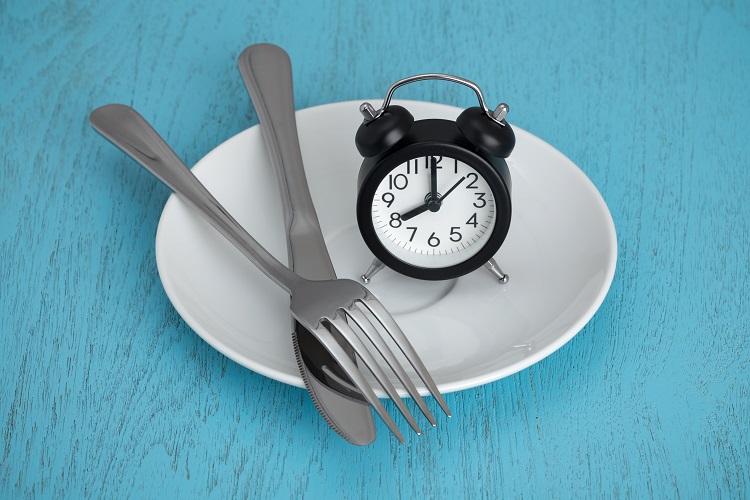Fasting is nothing new. Humans have been doing it for centuries because of food scarcity, religious beliefs, or simply because they don’t feel hungry.
In the past several years, though, the practice of “intermittent fastening” has exploded in popularity. Wolverine himself, Hugh Jackman, has sworn by it. The Kardashians have tried it. It’s possible you’ve done it without even realizing.
Which begs the questions: what is intermittent fasting, and how could it help you?
Intermittent fasting is the practice of restricting food intake during certain times of the day or week. The practice has many reported health benefits, including blood sugar control and mental clarity. In this article, we’ll focus on fasting in athletes.
Intermittent fasting is an umbrella term, and there are a multiple ways to do it. Here are three of the most common methods:
- Time-restricted eating involves fasting for a certain number of hours each day. The most common protocol is 16:8, which specifies 16 consecutive hours of fasting followed by eight hours in which you can eat.
- 5:2 fasting limits calorie intake to 500 calories a day twice a week with no specific calorie requirements for the other days. Alternate day fasting is a similar approach that permits just 500 calories per day every other day.
- Selective meal skipping involves skipping meals based on convenience and appetite.
Much of what we know about fasting in sports comes from Muslim athletes during Ramadan. Similar to 16:8 intermittent fasting, Ramadan restricts food intake for 11 or more consecutive hours a day. It’s difficult to gauge the long-term effects of fasting on performance, however, since Ramadan lasts only about one month.
“The scientific evidence we have on long-term outcomes of intermittent fasting is light, and it’s especially sparse in endurance athletes,” said Jennifer McDaniel, a Board Certified Specialist in Sports Dietetics and the owner of McDaniel Nutrition Therapy in St. Louis.
Because there’s still much to learn about fasting in sports, athletes should carefully consider the pros and cons before attempting it.
Hanger Issues
Are you prone to fits of grumpiness when hungry? If so, you may want to reconsider fasting.
With the possible exception of reaction time, there’s no strong evidence that fasting negatively impacts performance. Still, workouts may seem more daunting when you haven’t eaten. Athletes in some Ramadan fasting studies reported higher stress, more fatigue, and lower motivation during exercise.
If you’re often not hungry upon waking and you’re not undergoing intense training, you might do fine with fasting. But you may want to pass on fasting, or adjust your training or meal schedule, if you find it difficult to train on an empty stomach.
Speaking of Schedules
It’s rarely a good idea to try a new nutrition strategy during periods of high-volume or high-intensity training. Intermittent fasting is no exception.
“Using intermittent fasting aggressively or at the wrong period of training can compromise performance, carbohydrate storage, concentration and/or skill,” said McDaniel. “There’s also potential risk for poor recovery.”
Indeed, competitive athletes in small Ramadan studies performed better after breaking their fast. It’s not entirely clear whether this was due to psychological or physical factors.
As a dietitian, I find 5:2 or alternate day fasting to be too aggressive for many athletes. Those set on fasting may see great benefits from selective meal skipping, or from fasting 12 hours per day. Athletes who prefer 5:2 or alternate day fasting should consider resting on low-calorie days.
Protecting Your Muscles
Muscle is important for health and fitness, regardless of your activity of choice. At least one study suggests that long-term alternate day fasting decreases muscle protein synthesis while enabling muscle protein breakdown. In other words, fasting could cost you some muscle.
You may be able to preserve muscle mass by incorporating resistance exercises and consuming adequate dietary protein. Healthy adults need at least 0.36 grams of protein per body weight per day. Athlete needs are often higher, depending on the sport.
Time will tell if intermittent fasting deserves the fanfare it’s receiving. Until we know the long-term effects of the practice on athletes, it’s best to ease into it slowly and cautiously.
————————————————
Fasting for Weight Loss
There are lots of reasons why athletes may become interested in fasting, but the most common is weight loss.
“The draw to intermittent fasting for most athletes I’ve worked with revolves around changing body composition,” said McDaniel. “In my own practice, I’m more likely to use fasting with non-athletes as a tool in one’s weight management toolbox. However, if an athlete is in a period of training in which weight loss is ideal, intermittent fasting might be an appropriate strategy.”
Studies suggest that weight loss of 7 to 11 pounds is typical after following popular intermittent fasting protocols for 10 weeks. This may indirectly boost performance in locomotive sports. For example, small studies on runners suggest that a weight loss of 11 pounds could shave up to 2 minutes off the 5k time of someone who normally runs 9-minute miles.
How does it work? Truly, there’s no magic. The fasting window creates a calorie deficit, and weight loss occurs when not enough calories are eaten to compensate for that deficit. In other words, people who lose weight on intermittent fasting simply take in fewer calories than they burn.
In the long run, intermittent fasting is no more beneficial for weight loss than other low-calorie approaches. The best strategy for weight loss is the one that will be easiest for you to stick with.
Author: Kimberly Yawitz is a regular contributor to Terrain Magazine


Leave A Comment